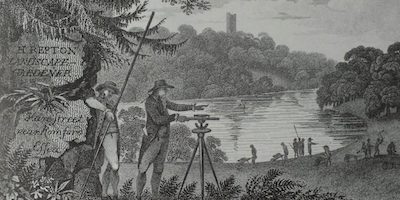
Celebrating Humphry Repton was organised by the Gardens Trust in 2018 to mark the bicentenary of his death. Repton was the last great landscape designer of the eighteenth century, and famous for his Red Books. County Gardens Trusts and other groups around the country arranged events and published books celebrating Repton’s work.
Celebrating Humphry Repton
Repton was born in 1752 in Bury St Edmunds, Suffolk and first trained in the textile business. As he was unsuccessful in business, he set himself up as a landscape gardener. Repton went on to design around 400 hundred English landscapes and gardens, and became a worthy successor to the great Capability Brown.
Estates where Repton worked include Tatton Park in Cheshire, Uppark House in West Sussex, Welbeck Abbey in Nottinghamshire, and Woburn Abbey in Bedfordshire. He famously produced ‘Red Books’ or folios to present his proposed improvements, in order to show ‘before’ and ‘after’ views of the landscape.
Repton’s work links the landscape design of the eighteenth century and the gardenesque movement of the early Victorian years. At the end of his life he said ‘as a landscape designer I have never been superseded by a more successful rival. My own profession, like myself, was becoming extinct.’
Find out more about Humphry Repton’s life and work.
Watch talks about new research on Repton on our YouTube channel.
During the bicentenary, we compiled an archive of Humphry Repton research materials by County Gardens Trusts and others.
As part of the celebrations, Historic England added Humphry Repton’s landscapes to their interactive map of Designed Landscapes, You can find out more about research by Historic England on their Humphry Repton landscapes page.
The Repton Gazette is a blog which explores a range of questions about Repton’s work.
Sharing Repton
The Gardens Trust used the Repton bicentenary as a springboard for its Sharing Repton: Historic Landscapes for All project, made possible by money raised by National Lottery players. Sharing Repton piloted activities to help welcome wider local communities to Repton landscapes, and then shared the learning experience with a national network of supporters.

